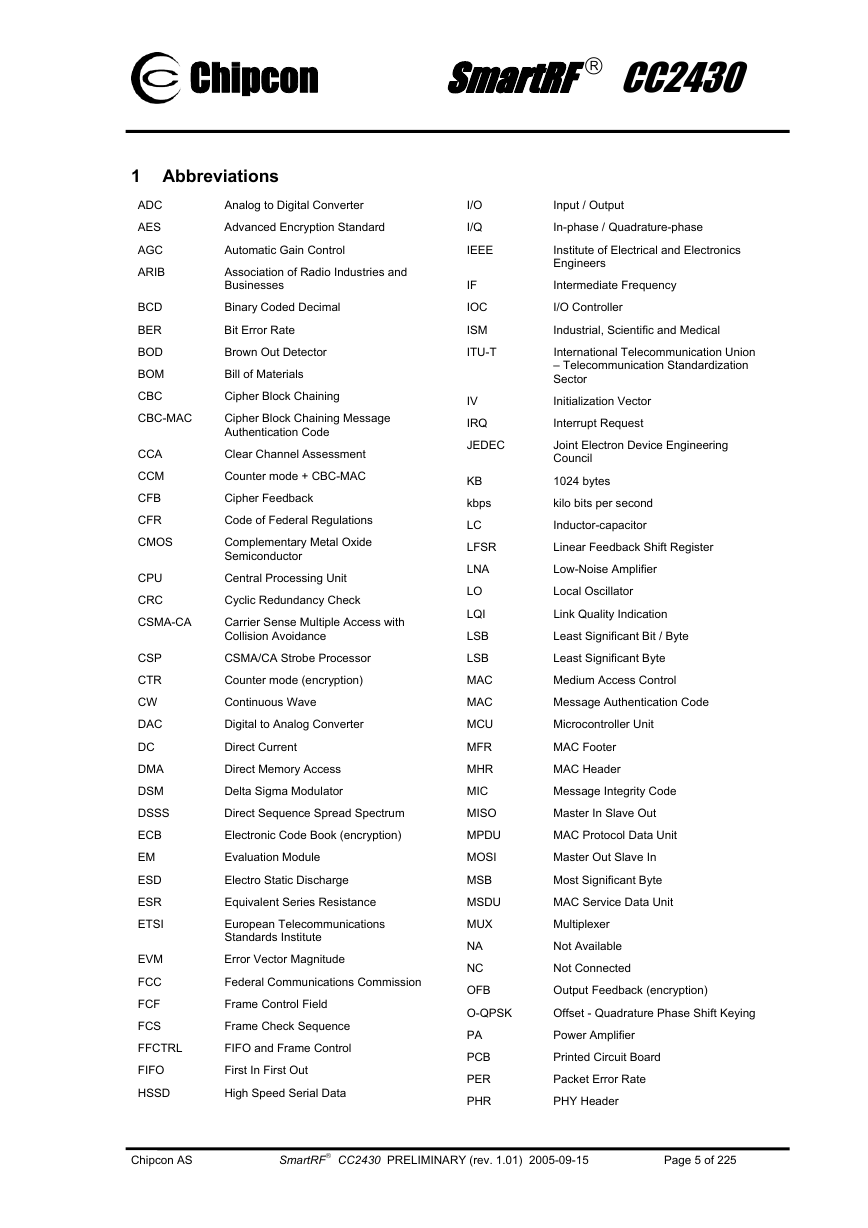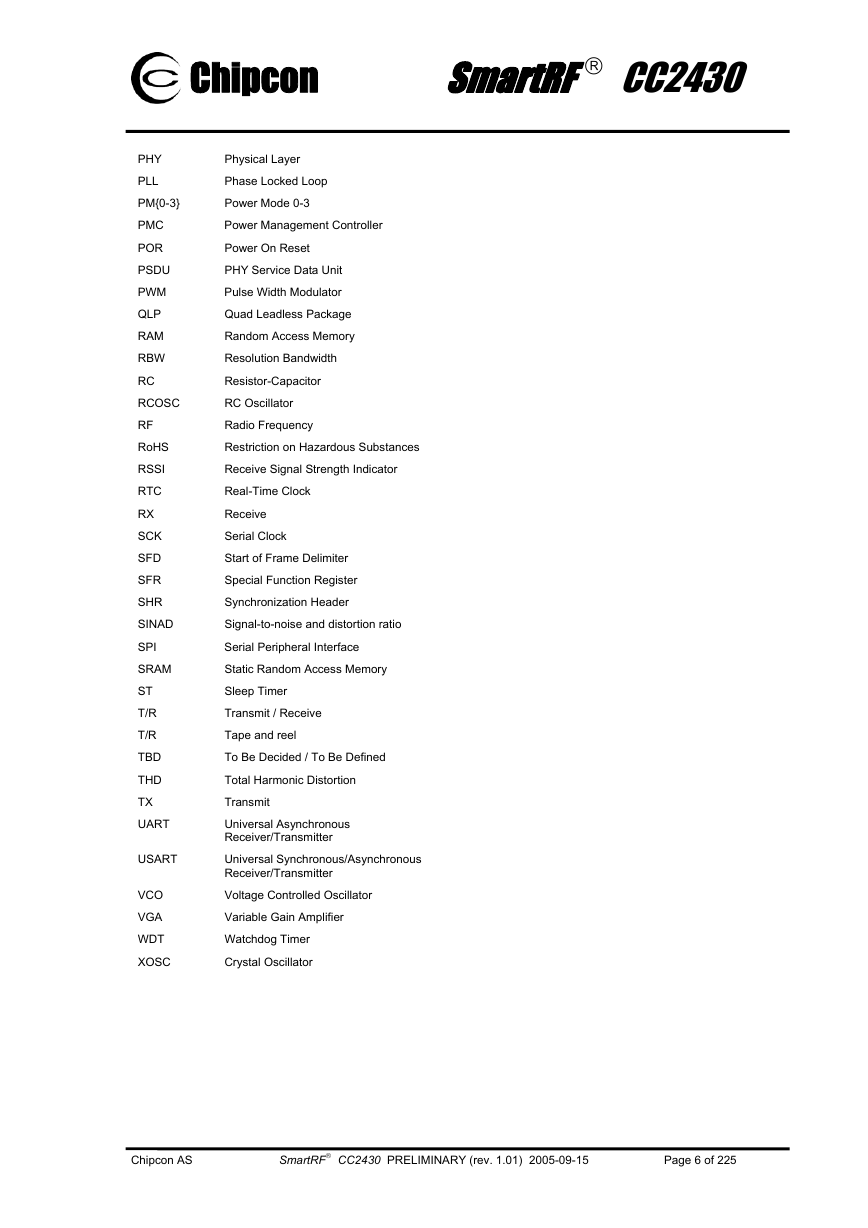Abbreviations
References
Register conventions
Features (continued from front page)
High-Performance and Low-Power 8051-Compatible Microcontroll
Up to 128 KB Non-volatile Program Memory and 2 x 4 KB Data M
Hardware AES Encryption/Decryption
Peripheral Features
Low Power
802.15.4 MAC hardware support
Integrated 2.4GHz DSSS Digital Radio
Absolute Maximum Ratings
Operating Conditions
Electrical Specifications
General Characteristics
RF Receive Section
RF Transmit Section
32 MHz Crystal Oscillator
32.768 kHz Crystal Oscillator
Low Power RC Oscillator
High Speed RC Oscillator
Frequency Synthesizer Characteristics
Analog Temperature Sensor
8-14 bit ADC
Control AC Characteristics
SPI AC Characteristics
Debug Interface AC Characteristics
Port Outputs AC Characteristics
Timer Inputs AC Characteristics
DC Characteristics
Pin and I/O Port Configuration
Circuit Description
CPU and Peripherals
Radio
Power Management
Application Circuit
Input / output matching
Bias resistors
Crystal
Voltage regulators
Power supply decoupling and filtering
8051 CPU
8051 CPU Introduction
Reset
Memory
Memory Map
Memory Space
Data Pointers
XDATA Memory Access
SFR Registers
CPU Registers
Registers R0-R7
Program Status Word
Accumulator
B Register
Stack Pointer
Instruction Set Summary
Interrupts
Interrupt Masking
Interrupt Processing
Interrupt Priority
Oscillators and clocks
Debug Interface
Debug Mode
Debug Communication
Debug Commands
Debug Lock Bit
Debug Configuration
Debug Status
Hardware Breakpoints
Flash Programming
RAM
Flash Memory
Memory Arbiter
Peripherals
I/O ports
General Purpose I/O
General Purpose I/O Interrupts
General Purpose I/O DMA
Peripheral I/O
USART0
USART1
Timer 1
Timer 3
Timer 4
ADC
Debug interface
32.768 kHz XOSC input
Unused I/O pins
I/O registers
DMA Controller
DMA Operation
DMA Configuration Parameters
Source Address
Destination Address
Transfer Count
VLEN Setting
Trigger Event
Source and Destination Increment
DMA Transfer Mode
DMA Priority
Byte or Word transfers
Interrupt mask
Mode 8 setting
DMA Configuration Setup
Stopping DMA Transfers
DMA Interrupts
DMA Configuration Data Structure
DMA registers
16-bit Timer, Timer1
16-bit Timer Counter
Timer 1 Operation
Free-running Mode
Modulo Mode
Up/down Mode
Channel Mode Control
Input Capture Mode
RF Event Capture
Output Compare Mode
Timer 1 Interrupts
DMA Triggers
Timer 1 Registers
MAC Timer (Timer 2)
Timer Operation
General
Up Counter
Timer overflow
Timer delta increment
Timer Compare
Capture Input
Overflow count
Overflow count compare
Interrupts
DMA Triggers
Timer start/stop synchronization
General
Timer synchronous stop
Timer synchronous start
Timer 2 Registers
Sleep Timer
Timer Operation
General
Timer Compare
8-bit Timer 3 and Timer 4
8-bit Timer Counter
Timer 3/4 Mode Control
Channel Mode Control
Input Capture Mode
Output Compare Mode
Timer 3 and 4 interrupts
Timer 3 and Timer 4 DMA triggers
Timer 3 and 4 registers
ADC
ADC Introduction
ADC Operation
ADC Core
ADC conversion sequences
ADC Inputs
ADC Operating Modes
ADC Conversion Results
ADC Reference Voltage
ADC Conversion Timing
ADC Interrupts
ADC DMA Triggers
ADC Registers
Random Generator
Introduction
Random Generator Operation
Semi random sequence generation
Seeding
CRC16
Registers
AES Coprocessor
AES Operation
Key and IV
Padding of input data
Interface to CPU
Modes of operation
CBC-MAC
CCM mode
Sharing the AES coprocessor between layers
AES Interrupts
AES DMA Triggers
AES Registers
Power Management
Power Management Introduction
PM0
PM1
PM2
PM3
Power Management Control
System clock
High-speed oscillators
32.768 kHz oscillators
Timer Tick generation
Data Retention
Power Management Registers
Power On Reset and Brown Out Detector
Watchdog Timer
Watchdog mode
Timer mode
Watchdog Timer Example
Watchdog Timer Register
USART
UART mode
UART Transmit
UART Receive
UART Hardware Flow Control
UART Character Format
SPI Mode
SPI Master Operation
SPI Slave Operation
Baud Rate Generation
USART flushing
USART Interrupts
USART DMA Triggers
USART Registers
FLASH Controller
Flash Write
DMA Flash Write
CPU Flash Write
Flash Page Erase
Flash Lock Protection
Flash Write Timing
Flash DMA trigger
Flash Controller Registers
Radio
IEEE 802.15.4 Modulation Format
Command strobes
RF Registers
Interrupts
Interrupt registers
FIFO access
DMA
Receive mode
RXFIFO overflow
Transmit mode
General control and status
Demodulator, Symbol Synchronizer and Data Decision
Frame Format
Synchronization header
Length field
MAC protocol data unit
Frame check sequence
RF Data Buffering
Buffered transmit mode
Buffered receive mode
Address Recognition
Acknowledge Frames
Radio control state machine
MAC Security Operations (Encryption and Authentication)
Linear IF and AGC Settings
RSSI / Energy Detection
Link Quality Indication
Clear Channel Assessment
Frequency and Channel Programming
VCO and PLL Self-Calibration
VCO
PLL self-calibration
Output Power Programming
Input / Output Matching
Transmitter Test Modes
Unmodulated carrier
Modulated spectrum
System Considerations and Guidelines
SRD regulations
Frequency hopping and multi-channel systems
Data burst transmissions
Crystal accuracy and drift
Communication robustness
Communication security
Low cost systems
Battery operated systems
BER / PER measurements
PCB Layout Recommendation
Antenna Considerations
CSMA/CA Strobe Processor
Instruction Memory
Data Registers
Program Execution
Interrupt Requests
Random Number Instruction
Running CSP Programs
Instruction Set Summary
Instruction Set Definition
DECZ
DECY
INCY
INCMAXY
RANDXY
INT
WAITX
WAIT W
WEVENT
LABEL
RPT C
SKIP S, C
STOP
SNOP
STXCALN
SRXON
STXON
STXONCCA
SRFOFF
SFLUSHRX
SFLUSHTX
SACK
SACKPEND
ISSTOP
ISSTART
ISTXCALN
ISRXON
ISTXON
ISTXONCCA
ISRFOFF
ISFLUSHRX
ISFLUSHTX
ISACK
ISACKPEND
Example programs
Radio Registers
Radio Test Output Signals
Voltage Regulators
Voltage Regulators Power-on
Evaluation Software
Register overview
Package Description (QLP 48)
Recommended PCB layout for package (QLP 48)
Package thermal properties
Soldering information
Plastic tube specification
Carrier tape and reel specification
Ordering Information
General Information
Document History
Product Status Definitions
Disclaimer
Trademarks
Life Support Policy
Address Information
















 uCOS-III的任务调度算法研究.pdf
uCOS-III的任务调度算法研究.pdf STM32F103x8B_DS_CH_V10(7STM32中文数据手册).pdf
STM32F103x8B_DS_CH_V10(7STM32中文数据手册).pdf FX2N系列PLC培训教程.pdf
FX2N系列PLC培训教程.pdf Modbus协议资料.pdf
Modbus协议资料.pdf WM8978中文资料(芯片资料).doc
WM8978中文资料(芯片资料).doc 5-1.【Codelab】HarmonyOS基于图像模块实现图库图片的四种常见操作.pdf
5-1.【Codelab】HarmonyOS基于图像模块实现图库图片的四种常见操作.pdf GX Developer 编程软件使用说明.pdf
GX Developer 编程软件使用说明.pdf MR-E伺服与FX3G接线图.pdf
MR-E伺服与FX3G接线图.pdf ATK-NEO-6M GPS模块常见问题汇总_201400721.pdf
ATK-NEO-6M GPS模块常见问题汇总_201400721.pdf STM32F407ZGT6(芯片资料).pdf
STM32F407ZGT6(芯片资料).pdf FM1715编程指南.pdf
FM1715编程指南.pdf Profibus教程-7.PROFIBUS-FMS.pdf
Profibus教程-7.PROFIBUS-FMS.pdf